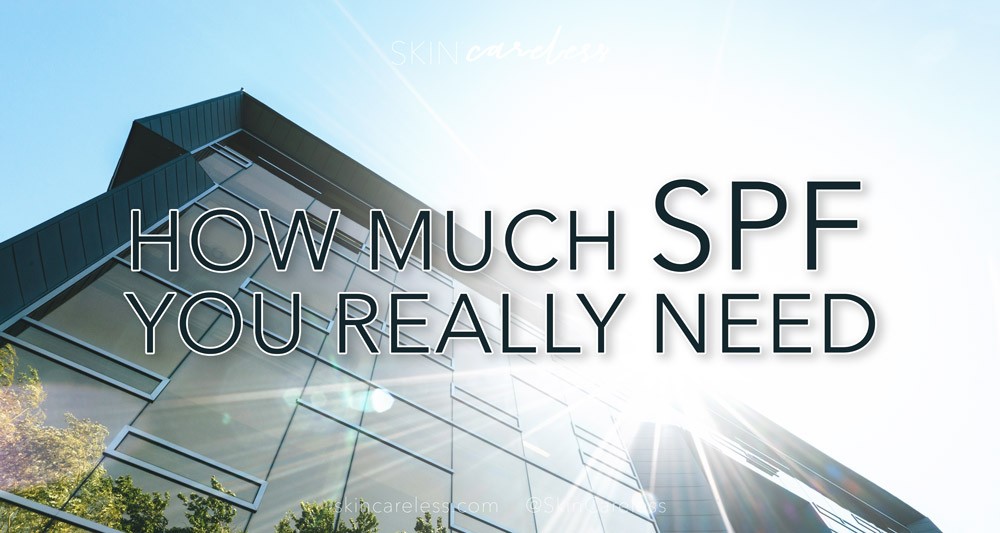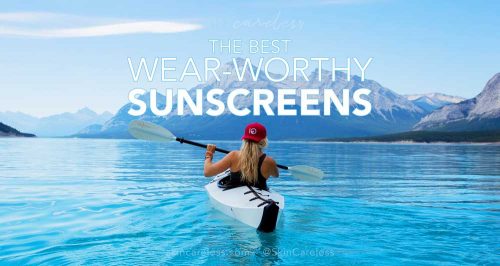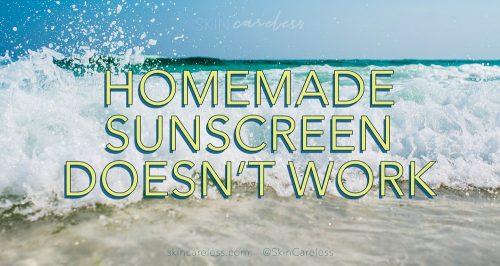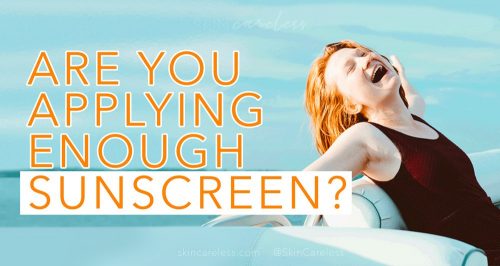By now I’m sure you realise the importance of using sunscreen every day. It’s at the core of a great anti-ageing strategy and overall body health. But when you’re at the store and faced with lots of sunscreen options, it’s easy to be overwhelmed by all the different types and brands.
But the main thing that really matters is the SPF.
Let’s talk about what is the minimum SPF you should be reaching for next time you buy sunscreen.
What is SPF (Sun Protection Factor)?
When looking at a sunscreen bottle, most of us know that a high SPF is good, but maybe not why it’s good. By understanding what SPF measures, we can better understand why it’s important and decide how much is right for us.
SPF is an acronym for Sun Protection Factor; a measurement of how long it takes someone to burn wearing vs. not wearing the sunscreen.
SPFs of each and every sunscreen market on the formula is learned through voluntary human testing. First, the laboratory applies the product on some parts of a participant both not others. Then, their skin is placed under a UV lamp that replicates the effect of the sun. They then measure and record the length of time it takes the unprotected areas to begin to sunburn, and compare this to the time it takes the protected areas to burn. The difference is expressed as a factor i.e. 2 times longer, 4 times longer, 25 times longer and so on.
A sunscreen awarded an SPF of 10, for example, means that it took participants in that sunscreen’s tests an average 10 times longer to burn while wearing it and thus it protects from approximately 90% of sunburn-causing UVB rays.
Obviously, the higher the SPF, the longer you could theoretically go without burning and the more protection you are getting from damaging UV rays.
So what SPF is enough?
The FDA classifies sunscreen in one of three categories: minimal protection, moderate protection and high protection. Anything up to SPF 12 is considered ‘minimally sun protective’, and anything over 30 is part of the ‘high protection’ category. Dermatologists and skin cancer specialists agree that SPF 30 is the minimum SPF required to effectively protect you against burning in the sun.
Is higher always better? What about SPF 70 or 100 or even higher?
SPFs can often range up to 50 and in some places even higher. Those must be even better, right?
Well Australia, one of the most sun-safe countries on a regulatory level, has disallowed labelling over this number (and the US is also attempting to at the moment).
While in theory yes, the higher the SPF the better, it’s thought that once you reach SPF 50 (protection against 98% of sun rays) there is not much to be improved upon. The nature of the measurement system means that as numbers get higher, the improvement between SPF measurements becomes smaller and smaller. An SPF of 100 only protects against 99% of rays, a mere 1% difference.
The formulation needed to make a sunscreen this effective may come at the cost of cosmetic elegance or ‘feeling’. If a sunscreen is super thick and greasy, you’re less likely to apply enough or want to reapply as needed.
And reapply you must. For example, if you burn naturally in 10 minutes, an SPF 50 will protect you for over 16 and a half hours. There’s no way your sunscreen is staying on that long, especially at a day on the beach with the salt water and sweat. So most of the time, you’re never seeing these high level sunscreens out to their full SPF potential before reapplication anyway.
Super high SPF sunscreens also tend to be thicker and less cosmetically elegant, meaning you might apply too thin of a layer and won’t want to wear them as much.
So it’s often better for those seeking maximum protection to stick to SPF 50 and apply generously and regularly instead.
UVA protection: Broad spectrum sunscreens
SPF is important, but it’s not the only thing to look out for on the bottle. Another marker of a great sunscreen is broad spectrum capabilities.
UVB rays are the kind of invisible light that burns the skin. It’s what scientists are measuring protection against when they’re testing for SPF. But there are also UVA rays, which do not burn the skin, but rather go deeper and cause cell changes and mutation. They can pass through glass and clouds and are present every day, regardless of weather. UVA rays are the cause of sun-induced skin damage and ageing, and skin cancers. SPF cannot reflect UVA protection, because it doesn’t make the skin burn, so there is no easy way to test for its exact effectiveness.
Broad spectrum is a label given where, in addition to its SPF rating (and thus its UVB protection), a sunscreen also filters a proportional percent of UVA rays. it’s determined based on extensive testing already done to pre-approved sunscreen ingredients which have estimated their protection factor ahead of time. The requirement for achieving the broad spectrum label is to have enough UVA-protective ingredients to create protection against 1/3 of the amount of the UVB protection offered. For example, a sunscreen with a SPF (UVB protection) of 30 must have a UVA protection factor of 10, meaning it takes 10 times longer to receive the same dose of UVA as unprotected skin would get.
For protecting yourself completely, choosing broad spectrum sunscreen is key. Without a broad spectrum indication, your sunscreen could offer you no protection against many skin cancers and premature ageing.
What exactly should you look for on a sunscreen bottle to show broad spectrum/UVA protection?
Every continent has a different way of denoting broad spectrum UVA protection on their sunscreen bottles. In the US and Australia, a simple mention of the words ‘broad spectrum‘ indicated that the sunscreen has been deemed UVA protective enough. In the EU, sufficient UVA protection is shown with the letters ‘UVA’ printed inside a circle, or with a star rating indicating how strong a protection of a you’re getting. In Japan, the UVA measurement is referred to as a ‘PA’ rating, and is followed by a number of ‘+’ signs – the higher the better. Aim for ‘PA++++‘, the current highest rating.
An SPF 30+ Broad-Spectrum (with the UVA circle or PA+++ or higher where applicable) sunscreen is plenty for most people in everyday situations. You should be able to find a range of these at any local pharmacy or store. Use it every day as part of your skin care routine!






[…] some. So do yourself a favour and pair these ingredients with liberal every day application of an appropriately high-SPF sunscreen, such as the lightweight Missha All Aound Safe Block or the mattifying Biore UV Milk (my personal […]
[…] to apply your 1/4 teaspoon of high SPF this […]
[…] a high SPF sunscreen to the end of your morning routine – applying it doesn’t even take an extra 30 seconds. […]
[…] are in control of so much of our appearance, and all we have to do is religiously use high SPF sunscreen and other protective measures like antioxidants. If this study doesn’t convince you, I don’t […]